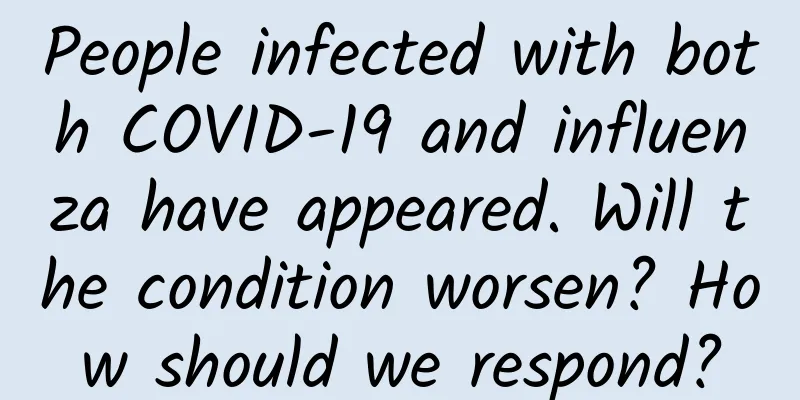People infected with both COVID-19 and influenza have appeared. Will the condition worsen? How should we respond?

|
According to media reports on January 2, Israel reports first case of Florona That is, cases of simultaneous infection with the new coronavirus and influenza virus. Image source: Screenshot from news website Some experts are concerned that this co-infection may lead to more serious illnesses, and some even worry that a new super virus may emerge. How serious is the co-infection? We still need to look at it from a scientific perspective. First of all, it is not rigorous to say that Israel has discovered the world's first case of co-infection with the new coronavirus and influenza virus. On January 2, The Times of Israel reported that a pregnant woman in the country was found to be infected with both the new coronavirus and the influenza virus, marking the first case of "co-infection" in Israel. The media specifically pointed out that "some reports say this is the first case of such dual infection in the world, but as early as the spring of 2020, there were reports of patients with influenza and the new coronavirus in the United States." In fact, cases of co-infection with the new coronavirus and influenza virus are not uncommon and have occurred many times before. In late February 2020, the entire family of a patient in Queens, New York, tested positive for influenza and the new coronavirus; In April of the same year, researchers from the Stanford University School of Medicine also found a person co-infected with influenza and the new coronavirus while testing samples from patients with respiratory diseases in northern California. In May, researchers at the Barcelona Hospital in Spain wrote in The Lancet that the hospital had found four cases of co-infection at the same time, and called on the medical community to strengthen research on this phenomenon. According to a report by El Mundo on January 3, the head of the Catalan Health Bureau in Spain confirmed that there were several cases of dual infection of the new coronavirus and influenza virus in Catalonia, but he also pointed out that these cases were sporadic, not normal, and the patients' symptoms were mild. In addition, whether co-infection with the new coronavirus and influenza viruses will aggravate the condition remains an issue that deserves attention. Many studies believe that co-infection with multiple viruses may aggravate the condition. Saudi researchers have observed that patients co-infected with COVID-19 and influenza A (H1N1) are more seriously ill, with higher ICU admissions and mortality rates. The reason may be that influenza virus infection exacerbates the immune storm. In October 2020, researchers at Wuhan University published a preprint paper stating that experiments showed that influenza viruses can promote the entry of the new coronavirus into cells, causing mice to have a larger viral load and more severe lung damage. But some experts have different opinions. In October 2020, researchers at St. Barnabas Hospital in the Bronx, New York City, compared the medical data of 18 patients infected with both COVID-19 and influenza with those infected with COVID-19 alone. The results showed that there was no significant difference between the two in terms of indicators such as mortality. In addition to possibly affecting the severity of the disease, experts from the U.S. Centers for Disease Control and Prevention have warned that infection with both the COVID-19 and influenza viruses will increase the difficulty of treatment. For example, corticosteroids can be used to treat severe cases of the COVID-19, but may increase the risk of death in influenza patients. So, will the new coronavirus recombine with the influenza virus in the human body to produce a "super virus"? There is no research to support the claim that the new coronavirus and influenza virus will recombine. Coronavirus and influenza virus are two completely different viruses, and virus recombination usually occurs between similar viruses. However, this possibility cannot be completely ruled out. In 1988, Dutch scientists published a paper stating that they found traces of coronavirus and influenza C virus recombination on mouse hepatitis virus MHV-A59. In short, the global COVID-19 pandemic has made us nervous, but under the guidance of science, please do not panic too much. At the same time, Abdi Mahmoud, the WHO official in charge of the management of the new coronavirus infection incident, said on the 4th that the WHO still recommends 14-day isolation for those infected with the new coronavirus. He suggested that the best way to reduce the impact of the Omicron strain is to achieve the WHO's goal of vaccinating 70% of the population in each country by July this year. On January 4, in Canberra, Australia, citizens wearing masks waited for the bus at the station. Photo by Chu Chen, Xinhua News Agency How to prevent the frequent outbreaks of epidemics and the rampant spread of viruses? Under the shadow of the mutated novel coronavirus Omicron strain, the world entered 2022. Many people have a question in their minds: Can the new coronavirus pandemic gradually subside in the new year? Winter is the peak season for common respiratory infectious diseases such as influenza and pneumonia. Coupled with the current resurgence of the COVID-19 epidemic, it has further increased the difficulty of seeking medical treatment. Prevention and control experts have repeatedly stressed that if the new coronavirus and influenza are superimposed on each other in autumn and winter, it will cause: Differential diagnosis is very difficult, and the difficulty of implementing isolation measures has increased significantly; The consumption of social and medical resources has increased significantly, which may lead to an increase in the mortality rate; It has an impact on social psychology and social stability. The change of seasons, flu, and the epidemic, this pace is simply adding insult to injury! No one wants to experience this situation again... Picture丨TuChong Creative Scientific anti-epidemic measures are the key Mutated strains are a major threat to the global fight against the epidemic. Two months after the emergence of the Omicron strain, it has spread to hundreds of countries and regions around the world. At present, even if the symptoms caused by the Omicron strain are relatively mild, it is too contagious and may also cause the collapse of the medical system. The emergence of this strain also raises questions: Are the passive epidemic prevention strategies of some countries hindering the global fight against the epidemic? Are there any more terrible mutant strains coming? Is the "flu-like" epidemic a wishful thinking of some people? Vaccines are a powerful weapon against the epidemic, but more than 40% of the world's population has not yet received the COVID-19 vaccine. Filling the huge gap in vaccination is a daunting task, and developed countries are urgently required to fulfill their commitments. The upgrading of existing vaccines against mutant strains and the development of next-generation vaccines are being vigorously promoted. In the future, nasal spray and oral COVID-19 vaccines may be used. Some scientists are also studying universal coronavirus vaccines. Xinhua News Agency (Photo by Xu Guokang) Recently, COVID-19 drugs have been approved for marketing or emergency use authorization both at home and abroad, which can help reduce the risk of severe illness and death. Small molecule oral drugs are convenient for early use and easy for developing countries to purchase and use, and have received considerable attention. Throughout the history of human development, science and technology are the most powerful weapons for humans to fight against diseases. With both vaccines and medicines available, there is hope that the COVID-19 pandemic can be effectively controlled as long as we adhere to scientific policies and work together. The World Health Organization said: "2022 must be the year we end this pandemic." In addition, new progress may be made this year in the development of vaccines for diseases such as malaria and AIDS. Beware of the "double kill" of COVID-19 and influenza Protect yourself, protect your family Comprehensive sources: China Center for Disease Control and Prevention, Xinhua News Agency, Science and Technology Daily, etc. |
<<: The Great Voyage丨Were Tang Dynasty wooden sailing ships so advanced?
>>: “Skiing veteran” Shan Zhaojian: It is important to do this with a smile on your face!
Recommend
Tractica: Global deep learning software market will reach $67.2 billion in 2025
Deep learning is a buzzword that has received muc...
When buying movie tickets, don’t fight for the last row.
I want to ask everyone, when you go to the cinema...
How Apple Watch can succeed as Android Wear struggles
[[128623]] Given the current slow development tre...
Why do humans like to pick their feet?
What do the guys who pick their toes around you l...
Tencent's love-style product operation method
What does it feel like to be in love? Most of the...
Battlefield 1 PS4 Edition Review: A Dream Return to the First World War: Old Soldiers Remain Undead and Pick Up Guns Again
In the golden month of October, Battlefield 1 was...
Swift’s Different Flavors of Type Erasure
Preface The overall goal of Swift is to be both p...
Why did Yongle move the capital? The splendor of the Ming Dynasty behind the "convex" shape of Beijing
When talking about the Ming Dynasty and Emperor Y...
12 historical documents prove that China was the first to discover and name the South China Sea Islands
As early as the Qin and Han dynasties more than 2...
Case analysis: Is it difficult for paid course mini-programs to grow? Achieve 30% growth using this method
In this case, the fission mechanism of inviting f...
What changes will occur in your body if you eat and drink heavy-tasting food for a long time?
The pace of life is fast nowadays, and many peopl...
How to write a crisis public relations plan?
Introduction: Behind every event, there is a trut...
How to do KOL marketing promotion? 4000 words of dry goods presented
With the rise of short video platforms such as Ti...
Shanghai official reminder! Doing this is very dangerous!
Recently, Shanghai's rumor-busting platform c...









